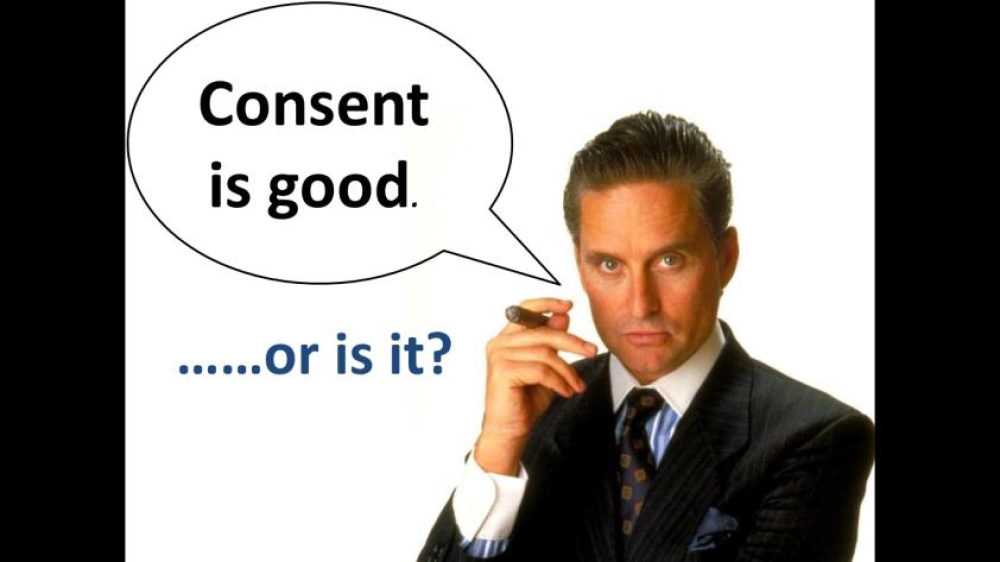Consent is good.
25 Aug 2015

Revenue-hungry clients tend to brief their marketing departments/ agencies to do whatever is necessary to gather more opt-ins.
But I suggest they ask themselves: “Do we really want to maximise consent?”
Let’s assume the imaginary client is Gordon Gekko, the myopic money-focused trader, who (to only slightly misquote him) says: “The point is ladies and gentlemen, consent is good”. A view often echoed by clients who are intent on increasing permissions-to-contact.
So at a time when consent is increasingly difficult to obtain, why check whether brands are truly prepared to use all and any means to maximise marketing permission?
I shall restrict my explanation to entirely commercial rather than ethical arguments; shunning motivations driven purely by desire to do the right thing rather than to make money. But (of course) I shall always stay on the correct side of data protection law.
Constant review of fast.MAP Consent Optimising Benchmarks results has tutored the fast.MAP team in the dark art of maximising consent by creatively using astute language, appealing design and increased choice of communication channel.
An uncomfortable truth
While perfecting these dark arts an uncomfortable truth was discovered - confusion can increase consent. Take a look at the attribute scores (below) for a statement deliberately created to confuse by mixing opt-in tick boxes for some media and opt-out boxes for others
It achieved a high (60%) level of consent and because the benchmark objectively examines the reasons for as well as the levels of consent this statement was revealed to be confusing. Further investigation revealed it was performing well partly because it was confusing.
Confusion costs money
However, our imaginary client is devoid of morals and ruthlessly commercial and the statement is lawful so there are no legal issues.
So should Gordon Gekko be concerned he is achieving consent through confusion? The answer is “yes”, for three very commercial reasons.
First, about 10% of the 60% consent was generated by confusion and so 10% did not intend to give permission. When subsequently contacted they are unlikely to be as profitable as those who knowingly gave assent.
There is no way of identifying this 10%, so time and money will be wasted contacting them and they will depress the overall response rates. More commercially worrying is the knowledge that the mix of confused and legitimate consenters could render contact with the overall list unprofitable, meaning the infected list will cost money.
Even worse, around 7.5% of those who did not consent actually intended to consent, but have now been removed from the communication programme. This will also cost money.
And the rouse is damaging Gekko’s business reputation, because many of the prospects who read the confusing statement will be left with a negative impression.
Consumers know about and understand marketing consent and they don’t like to be confused. But some brands persist in generating confusion to boost databases size. Such manipulation erodes trust and brand credibility and makes people more wary about buying.
Consumers logically think: “If a brand is deliberately confusing me with this consent statement; why should I trust what it says to me about its products or services?” This attitude will affect sales and cost money.
And there’s a risk people will air their dissatisfaction on social media and have their views picked up by the press for wider broadcast.
This is why I would suggest Gordon adopt a more complex, but ultimately more commercially-rewarding aim - to optimise rather than maximise consent.
Consent is good - as long as people know what they are consenting to.
If you enjoyed reading this then there are more here;
Consent is power http://bit.ly/1K8TwVU
Wake up and smell the consent http://bit.ly/1Uw6YJf
Marketing consent is disappearing… http://bit.ly/1HXTYpe

Interesting stuff. But what was the 'statement deliberately created to confuse by mixing opt-in tick boxes'?
Zettasphere
Email Marketing Consultant